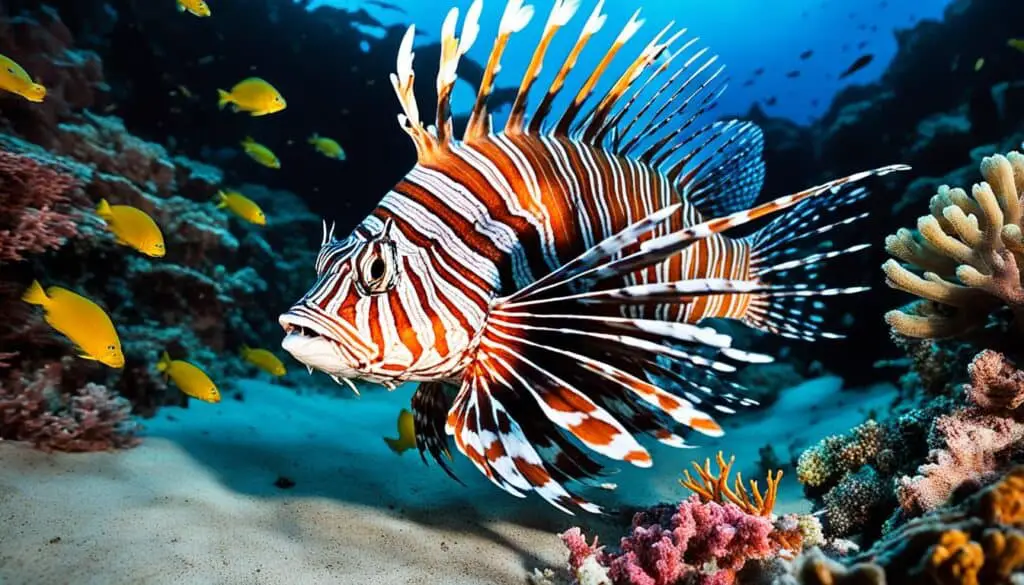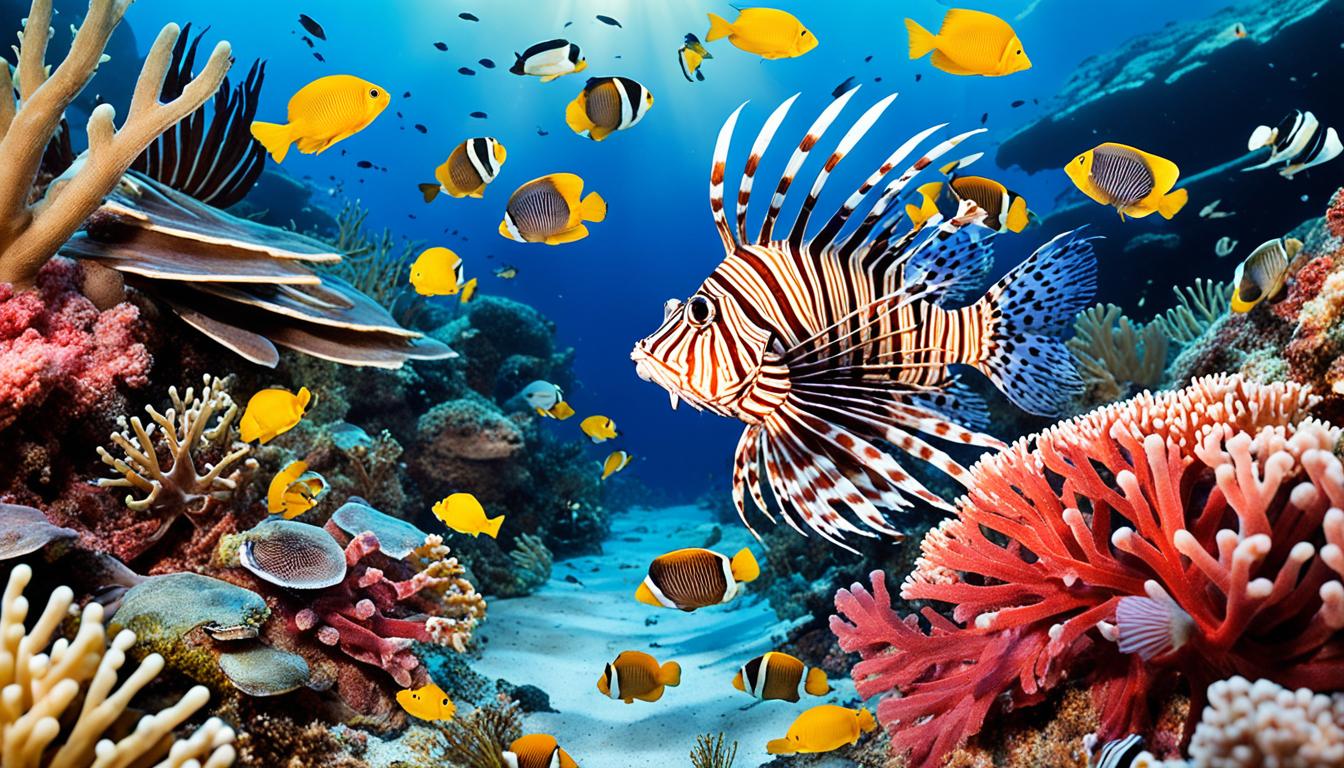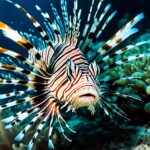Lionfish are known for their bright colors and have become a big problem in the ocean. They have changed the balance in many marine ecosystems. By looking into how they interact with other sea creatures, we see how they can harm local life and coral reefs. Understanding their effect on the ocean helps us see the big impact they have in places they don’t belong.
Lionfish as Invasive Species in Marine Ecosystems
The lionfish has become a big problem in marine ecosystems, especially in the western North Atlantic. It shows how this species has changed local habitats and threatened native marine life.
History of Lionfish Invasion
In the mid-1980s, lionfish were first brought to U.S. waters, mainly from aquarium releases. They have few natural enemies and can reproduce quickly. This has led to a huge increase in their numbers over the years.
Studies show they are spreading fast, causing big problems for local ecosystems as they move into new areas.
Current Range and Habitat
Now, lionfish live in the Atlantic Ocean, Gulf of Mexico, and Caribbean waters. They can live in many places, like coral reefs, wrecks, estuaries, and mangroves. Their numbers are growing, with some areas having over 200 lionfish per acre.
| Parameter | Details |
|---|---|
| Origin | Indo-Pacific Region |
| First Recorded in U.S. Waters | Mid-1980s |
| Key Habitats | Coral reefs, wrecks, estuaries, mangroves |
| Population Density | Exceeds 200 adults per acre |
| Impact on Ecosystem | Threatens coral reef health and native species |
How do lionfish interact with other marine life?
Lionfish play a big role in marine ecosystems. They change the balance by being top predators in reef habitats. This affects the way other species live and interact.
Predator-Prey Dynamics
Lionfish are at the top of the food chain in their ecosystems. They hunt with skill and eat many small fish. Some lionfish can eat prey as big as half their own size, showing their strength.
This hunting leads to fewer fish in the area. It changes the balance of who eats what in the ecosystem.
Impacts on Native Fish Populations
Lionfish have a big impact on native fish. Studies show they can cut the number of reef fish by up to 79%. They also compete with fish like snappers and groupers for food.
This can harm the balance of the coral reef ecosystem. Without natural predators, lionfish can grow too much, hurting native species.
| Impact Category | Description |
|---|---|
| Lionfish Feeding Behavior | Involves consuming fish shaping the demographics of reef communities. |
| Interaction with Prey Species | Intensive predation leads to decreased populations of smaller fish. |
| Impacts on Native Fish Populations | Significant declines in recruitment rates of native species observed. |
| Lionfish Effects on Fisheries | Affect local commercial fisheries by reducing fish species crucial for economy. |
| Lionfish Competition | Direct competition with native top predators for available food resources. |
Lionfish Behavior Towards Other Marine Species
Lionfish have interesting behaviors that affect other sea creatures. They hunt using special techniques and compete for resources in their homes.
Stalking and Hunting Techniques
Lionfish use clever ways to catch smaller fish. They trap them in small spaces with their big fins. Then, they blow water at the fish to get them close.
This makes it easy for the lionfish to catch their prey quickly. It helps them hunt better.
Competition for Resources
Lionfish compete with native species for food and space. They eat over 70 different fish types, which can harm local fish populations. This leads to fewer fish for other sea creatures.
The lionfish can change the balance in local ecosystems. This also affects communities that rely on fishing for their livelihood.

Lionfish Ecological Relationships
Lionfish are key players in the health of coral reefs. As they grow in number, their impact on reefs becomes clear. They mainly eat herbivorous fish, which are vital for keeping algae in check. Without these fish, algae can take over, harming the reef.
This imbalance makes reefs more vulnerable to threats like climate change and pollution. The ecosystem suffers, struggling to stay healthy.
Effects on Coral Reef Health
Lionfish harm coral reefs in many ways. When they eat herbivorous fish, algae grows too much. This can block sunlight and nutrients from reaching corals. Corals weaken and may die, putting the whole ocean at risk.
Reproductive Strategies and Population Growth
Lionfish breed quickly, which is why they’re so hard to control. A single female can lay 12,000 to 15,000 eggs every four days. This leads to a fast-growing population that spreads quickly.
This growth makes lionfish a big problem for local fish and ecosystems. Knowing about their breeding habits helps us fight their spread and protect our oceans.
Efforts to Manage Lionfish Populations
The lionfish invasion is a big problem for marine life. Groups like NOAA are working hard to stop it. They teach people how lionfish harm local wildlife and encourage community action. This helps everyone understand their part in fighting this invasive species.
To control lionfish, fishing derbies are organized. These events get divers and fishermen to remove lionfish from the sea. They also build a sense of community and shared duty. Plus, making lionfish a food option could help control their numbers, turning a problem into a resource.
Managing lionfish needs teamwork from local groups and big agencies. Working together helps everyone have the same goals. With a plan and community support, your area can help stop the lionfish invasion.
FAQ
How do lionfish interact with other marine life?
Lionfish are top predators in the ocean. They eat small fish and compete with native species for food. This affects local ecosystems a lot.
What is the impact of lionfish on marine ecosystems?
Lionfish harm marine ecosystems by eating native fish. This disrupts biodiversity and threatens coral reefs. Coral reefs are key for many marine creatures.
How do lionfish affect native fish populations?
Lionfish reduce native fish populations by up to 79%. Native fish have to fight for food with lionfish. This can lead to fewer fish overall.
What hunting techniques do lionfish use?
Lionfish hunt in a special way. They use big fins to trap prey and blow water to lure them. This makes them very good at catching food.
How do lionfish compete with native predators?
Lionfish compete with predators like snappers and groupers for food. This can make these native species decline. It upsets the balance in the ocean.
What effect do lionfish have on coral reefs?
Lionfish eat fish that eat algae, which helps keep reefs healthy. Without these fish, algae can grow too much. This hurts coral reefs, especially when reefs face other threats like climate change.
How do lionfish reproduce?
Lionfish can have a lot of babies. A single female can release 12,000 to 15,000 eggs every four days. This helps their numbers grow fast.
What are the challenges of managing lionfish populations?
It’s hard to control lionfish because they reproduce quickly and don’t have many natural enemies. Many groups work together to try to manage them.
What strategies are in place to control lionfish populations?
There are efforts to teach the public, hold lionfish derbies, and make lionfish a sought-after food. This helps control their numbers better.







